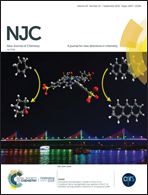Tracking the absence of anion–π interactions in modified [23](1,3,5)cyclophanes: insights from computation†
Abstract
Using DFT-based computational tools, the capabilities of [23](1,3,5)cyclophanes and their analogs, containing 1,3,5-triazine and 1,3,5-triphosphinine rings, to recognize anions were addressed. The impacts of such chemical modifications in the cyclophane scaffold and how they affect the anion recognition were explored since they are crucial to designing new and more efficient anion receptors. Long-range effects of transition metal coordination on the anion recognition were also investigated by the coordination of [Cr(CO)3]0 at the lower ring of cyclophanes leading to the piano-stool complexes. The role of such modifications on the interaction with anions was analyzed in details by considering the interactions between the upper ring of all proposed hosts with anions of different shapes and charges, including Cl−, Br−, NO3−, BF4−, SO42−, and PO43−. The interactions were rationalized in the light of energy decomposition (ETS-NOCV), wavefunction (NBO), and molecular electrostatic potential (MEP) analyses. The main findings reveal that the chemical modifications (substitution of 3 C–H groups at the upper ring by N and P) do not lead to significant changes on the structural features of cage-type cyclophanes, but modify their capabilities to recognize anions in a significant way, since very stable host–guest systems are formed and kept by strong σ-interactions and hydrogen bonds. The coordination of [Cr(CO)3]0 group amplifies such effects noticeably by withdrawing the electronic density from the host scaffold. Our results suggest that tuning the host–guest interaction by modification of the cyclophane structure is an important strategy to the rational design of anion receptors.
cyclophanes: insights from computation](/en/Image/Get?imageInfo.ImageType=GA&imageInfo.ImageIdentifier.ManuscriptID=C9NJ02776A&imageInfo.ImageIdentifier.Year=2019)


 Please wait while we load your content...
Please wait while we load your content...